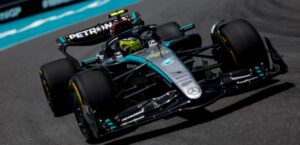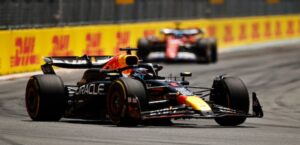De allereerste wintertest van het nieuwe seizoen zorgde voor heel wat bruikbare data voor de teams. Maar ook Pirelli haalde opnieuw haar lijst met statistieken boven. Voor de volledigheid geven we hieronder de volledige lijst met statistieken in het engels weer …
Testing Facts:
The teams are allocated 100 sets of tyres per car per year for testing purposes. The teams concentrated on working their way through the different compounds, in order to get an initial read about how the latest generation of deliberately fast-wearing tyres from Pirelli interacted with their new cars, both when new and used. Pirelli brought a total of 35 sets per car to this test (20 chosen by Pirelli, 15 by each team).
Ambient and track temperatures were cool, in the region of 15 degrees centigrade average most days, which led to a risk of graining. This occurs when a tyre slides if it is not up to temperature, and the friction against the track surface creates a wave-like pattern of wear, known as graining. This was mostly noted in the very cool conditions of the morning – sometimes with temperatures of less than five degrees centigrade – and accentuated by the abrasive surface.
With the conditions and track layout at Jerez not really typical of anywhere else this year, the time difference between the compounds is not expected to be completely representative of the rest of the season.
More Testing Facts:
– Most laps of Jerez: Gutierrez – 252 laps; Di Resta – 240 laps; Massa – 227 laps.
– Some teams were able to run up to 700 kilometres per day: the equivalent of more than two grand prix distances.
– None of the intermediate or wet tyres were used to set a lap time, as conditions remained completely dry throughout all four days.
– As well as evaluating cars and tyres, teams also carried out pit stop practice.
– The orange marking for the hard tyre was seen for the first time, replacing last year’s silver.
– The technical layout of Jerez with its slow corners placed heavy demands in terms of traction: particularly on the rear tyres.
– The high macro-roughness of the track at Jerez is caused by a lack of bitumen in the asphalt, leading to a relatively open surface, which creates the abrasion.
Testing numbers:
Total number of sets brought to Jerez: 385 sets which equals 1540 tyres
– of which supersoft tyres: 7 sets
– of which soft tyres: 49 sets
– of which medium tyres: 157 sets
– of which hard tyres: 95 sets
– of which intermediate tyres: 42 sets
– of which wet tyres: 35 sets
Total amount of sets used: 251
– of which supersoft tyres: 3 sets
– of which soft tyres: 33 sets
– of which medium tyres: 137 sets
– of which hard tyres: 74 sets
– of which intermediate tyres: 3 sets
– of which wet tyres: 1 set
Longest run:
– 20 laps on the hard compound
– 24 laps of the medium compound
– 12 laps on the soft compound
– 8 laps on the supersoft compound
– 3 laps on the intermediate compound
– 1 lap on the wet compound
Highest / lowest ambient temperature over four days: 3 °C (day 3) / 22 °C (day 1)
Highest / lowest track temperature over four days: 5 °C (day 3) / 28 °C (day 1)
Testing Times (top-3):
Day 1
1. Jenson Button, McLaren 1.18.861 Hard New
2. Mark Webber, Red Bull 1.19.709 Medium New
3. Romain Grosjean, Lotus 1.19.796 Hard New
Day 2
1. Romain Grosjean, Lotus 1.18.218 Soft New
2. Paul Di Resta, Force India 1.19.003 Soft New
3. Daniel Ricciardo, Toro Rosso 1.19.134 Medium New
Day 3
1. Felipe Massa, Ferrari 1.17.879 Soft New
2. Nico Rosberg, Mercedes 1.18.766 Medium New
3. Sebastian Vettel, Red Bull 1.19.052 Medium New
Day 4
1. Kimi Räikkönen, Lotus 1.18.148 Soft New
2. Jules Bianchi, Force India 1.18.175 Soft New
3. Sebastian Vettel, Red Bull 1.18.565 Hard New
a:0:{}
Gewoon nieuwsitem
a:0:{}











